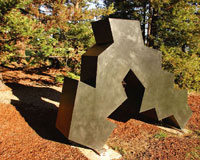 Photo: Diana Rogers/SLAC |
Seismic metal shoes
After waiting more than a year for safety and maintenance arrangements, sculptor Douglas Abdell's Kryeti-Aekyad set foot outside the Stanford Linear Accelerator Center's main auditorium on August 6. The welded bronze sculpture's lightning-bolt legs stand seven feet high and ten feet heel-to-toe, poised mid-stride on earthquake-ready, steel-and-concrete platform shoes. The piece was donated to Stanford University by Gap clothing chain owners and art collectors Doris and Donald Fisher. The artist Abdell—US-born in 1947—created a "whole series of these works, these geometric, anthropomorphic sculptures that sort of look like they want to run away," says Hilarie Faberman, PhD, curator of modern and contemporary art for Stanford's Cantor museum.
Aekyad's two blocky zig-zags extend from an off-center apex downward, to balance in slots cut in specially-manufactured steel plates. The plates, in turn, are bolted into 12-inch-deep concrete soles for stability against northern Californian earthquakes. The steel is temporary. To prevent corrosion from electrolysis between the plates and Aekyad's silicon bronze feet, SLAC will replace the steel with sculpture-matched silicon bronze as soon as material becomes available.
Shawne Neeper






